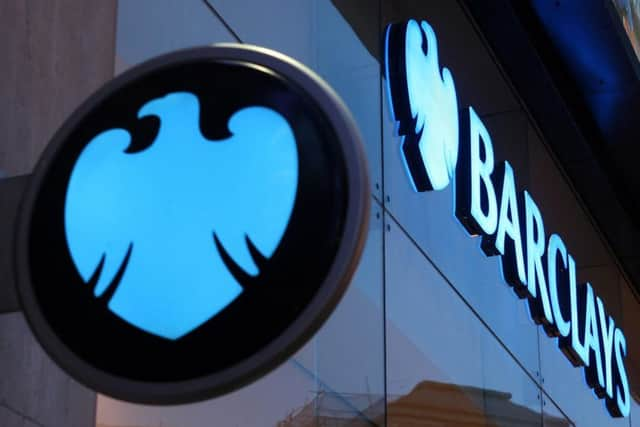Shares up at Barclays as bank sacks CEO Antony Jenkins


The bank said Antony Jenkins, who has led the bank since 2012, would be stepping aside, leaving its new chairman John McFarlane to take over executive duties until a permanent successor was appointed.
The shock decision came after the board decided new leadership was required to take the bank forward following a period of lacklustre results and uncertainty about the bank’s future structure.
Advertisement
Hide AdAdvertisement
Hide AdWhile lauding Mr Jenkins’ role in steering the bank through a period of rapid change over the last three years, Deputy Chairman Michael Rake said the board had decided Mr Jenkins did not have the blend of skills required to take the company forward.


“We are leaving value on the table and a new approach is required. As a group, if we aspire to bring shareholder returns forward, we need to be much more focussed on what is attractive, what we are good at, and where we are good at it,” he said in a statement.
“We therefore need to improve revenue, costs and capital performance. We also need to become more externally focussed and deal with the internal bureaucracy by becoming leaner and more agile,” he added.
The bank said the change of leadership would not equate to a change in strategy at the bank.
Advertisement
Hide AdAdvertisement
Hide AdMr Jenkins leaves the bank with 12 months’ notice and will receive his current annual salary of £1.1m, £950,000 in role-based pay and a pension of £363,000 a year.
He became chief executive in summer 2012, replacing Bob Diamond, who left the bank in the wake of its involvement in the Libor scandal, which saw banks attempt to fix the key interest rate.
Mr Jenkins promised to bring a new culture of decency to the bank, although the lender now says it must improve its commercial performance.
He said: “In the summer of 2012, I became group chief executive at a particularly difficult time for Barclays. It is easy to forget just how bad things were three years ago both for our industry and even more so for us.”
Advertisement
Hide AdAdvertisement
Hide AdHe added: “I am very proud of the significant progress we have made since then. Our capital position is much stronger, our business model is more balanced, we are much more disciplined on cost management, we have made good progress in rebuilding our reputation and we are seen as a leader in the application of technology to our business.”
The shock move to axe Mr Jenkins sent the bank’s shares higher. Shares in the banking giant leapt 3 per cent after the group said chairman John McFarlane would take on an executive role until a successor is appointed.
Timeline leading up to Mr Jenkins’ departure
July 2012: Barclays is fined a record $450 million for manipulating Libor benchmark interest rates, prompting the resignation of CEO Bob Diamond and Chairman Marcus Agius. Chancellor George Osborne welcomes Diamond’s departure, saying he hoped it was the “first step towards a new culture of responsibility” in banking.
August 2012: Barclays names Mr Jenkins, previously head of its retail operations, as chief executive, signalling a shift from riskier investment banking. With a soft-spoken manner contrasting with Diamond’s more brash approach, Mr Jenkins says Barclays had made mistakes and had to change to recover from them.
Advertisement
Hide AdAdvertisement
Hide AdIt also names David Walker, a veteran of the British financial sector whose previous posts included chairman of Morgan Stanley International, as chairman.
September 2014: Barclays names John McFarlane, chairman of insurer Aviva and former chief executive of Australia and New Zealand Banking Group, as chairman to oversee its efforts to stamp out wrongdoing and improve performance.
March 3 2015: Mr Jenkins threatens more cuts to Barclays’ underperforming investment bank after a 750 million pounds charge provides fresh evidence of the costs of past misdemeanours by traders.
Mr Jenkins accepts his first bonus since taking charge after the bank improves its capital strength and sheds unwanted assets, helping his pay to more than treble to £5.5m. Yet Barclays continues to be dogged by past conduct problems and lacklustre returns in investment banking and Mr Jenkins says he would take a knife once again to the investment bank arm if it does not improve its profitability.
Advertisement
Hide AdAdvertisement
Hide AdReturns in the investment bank were just 2.7 per cent in 2014, well short of its target of 12 per cent, although the bank says this was artificially low due to the impact of deferred pay from past years, conduct and legal costs and restructuring charges.
April 23 2015: Mr McFarlane formally takes over as chairman and signals his intention to accelerate its turnaround plan.
His arrival raises some expectations that the downsizing of the investment bank could accelerate, after he sold dozens of units in a revamp at insurer Aviva.
July 8 2015: Barclays ousts Mr Jenkins and says Mr McFarlane will assume executive duties until a permanent successor is appointed. McFarlane says independent directors of Barclays had been concerned about Mr Jenkins’s style of leadership for some time and he had spoken to the CEO last week. His exit is then confirmed at a board meeting late on Tuesday.